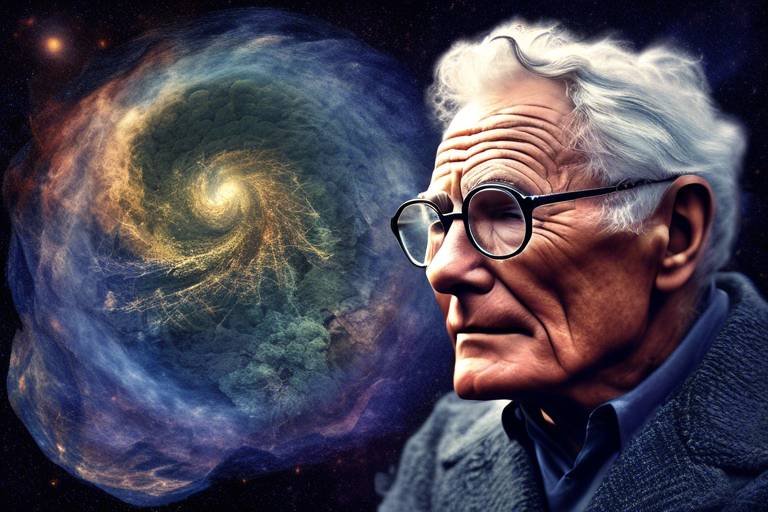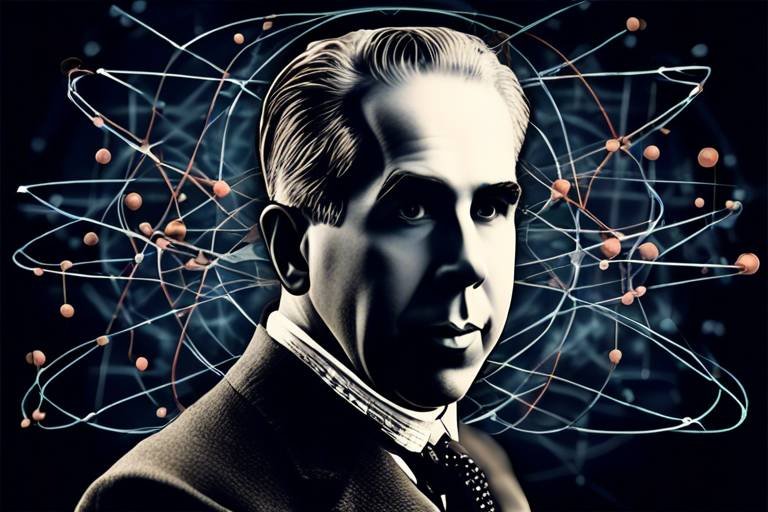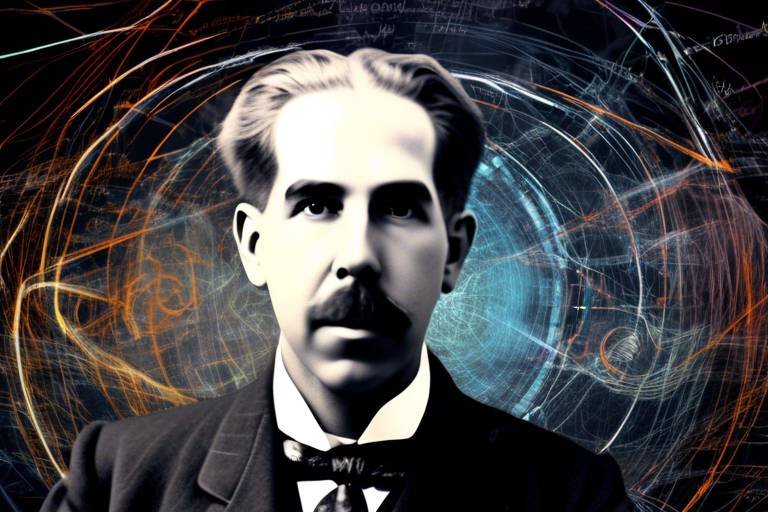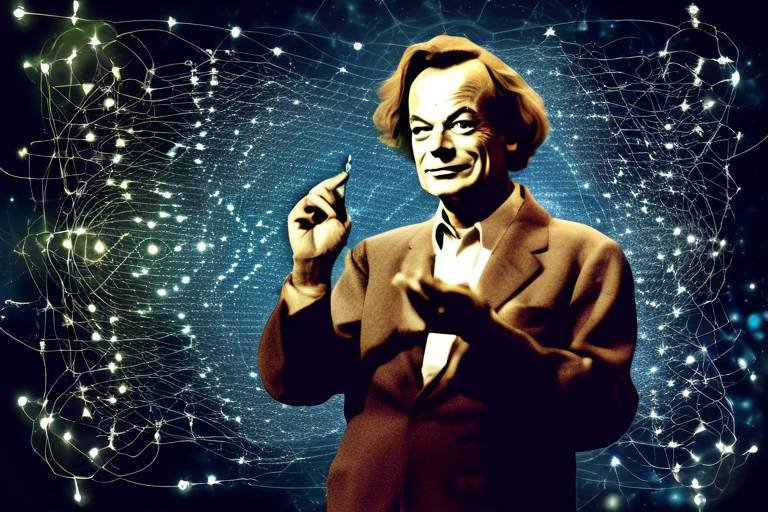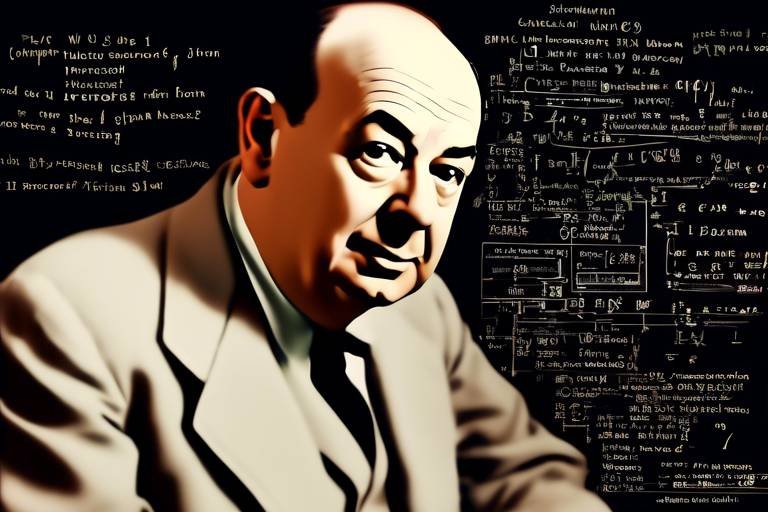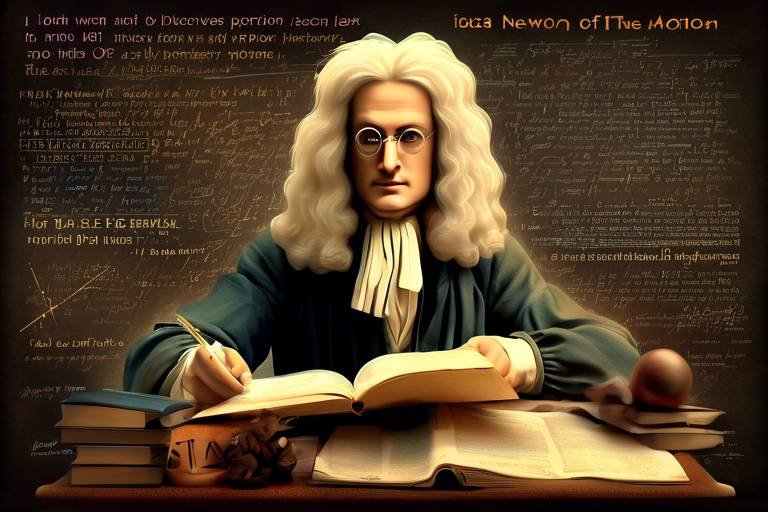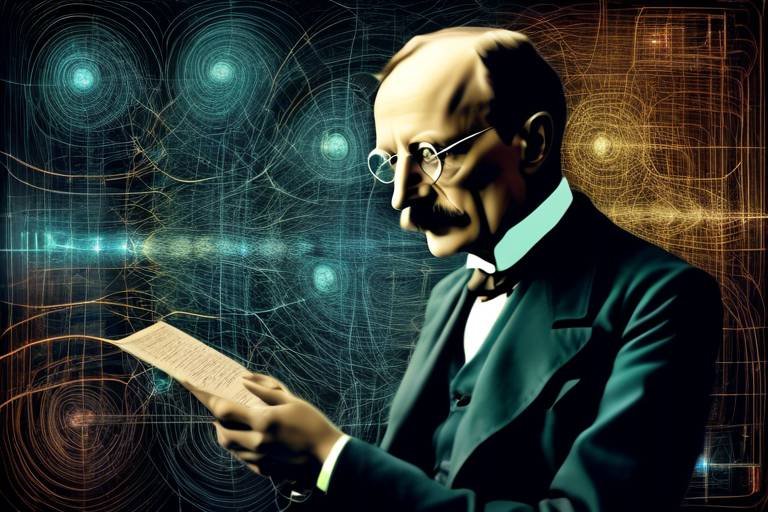The Discoveries of Paul Dirac in Quantum Physics
When we think about the history of physics, certain names stand out like beacons in the night. One such name is Paul Dirac, a physicist whose contributions have profoundly shaped our understanding of the quantum realm. Imagine a world where the rules of reality are not what they seem, where particles can exist in states that defy our everyday experiences. Dirac was not just a spectator in this strange world; he was a trailblazer, illuminating the path with his groundbreaking theories. His work has not only influenced quantum mechanics but has also paved the way for modern physics as we know it today.
Dirac's journey into the depths of quantum physics began with a simple yet profound question: How can we reconcile quantum mechanics with the principles of special relativity? This inquiry led him to develop what is now known as Dirac's Equation. This equation was revolutionary, merging the seemingly disparate worlds of quantum theory and relativity into a cohesive framework. It didn't just stop at explaining existing phenomena; it boldly predicted the existence of antimatter, a concept that was both thrilling and perplexing to physicists of his time.
But what exactly is antimatter? To put it simply, it's like the mirror image of matter itself. For every particle that makes up the world around us, there exists an antimatter counterpart with the same mass but opposite charge. Dirac's prediction of antimatter opened a Pandora's box of possibilities, reshaping our understanding of the universe. It was as if he had handed physicists a key to unlock new realms of exploration, leading to the discovery of the positron, the antimatter counterpart of the electron.
The experimental confirmation of the positron in 1932 was nothing short of a revolution. It validated Dirac's theories and marked a pivotal moment in physics. This discovery not only confirmed Dirac's insights but also ushered in a new era of research in particle physics and cosmology. Suddenly, physicists were grappling with questions about the very fabric of the universe, the nature of matter, and the fundamental forces that govern everything from the tiniest particles to the grandest galaxies.
Dirac's work didn't just stop at antimatter; it laid the foundation for modern particle physics. His classification of particles into fermions and bosons clarified the fundamental differences in their behavior, influencing our understanding of matter and forces in the universe. Fermions, which include electrons and quarks, obey the Pauli exclusion principle, meaning no two can occupy the same quantum state simultaneously. In contrast, bosons, such as photons and gluons, can exist in the same state, allowing them to act as force carriers.
Furthermore, Dirac's contributions extended into the realm of quantum field theory, bridging the gap between quantum mechanics and classical field theories. His innovative mathematical notation, known as Dirac notation, simplified the complexities of quantum mechanics, making it more accessible and enhancing the clarity of calculations involving quantum states, operators, and measurements. This notation has become a staple in the toolkit of physicists, streamlining the process of understanding and manipulating quantum systems.
The implications of Dirac's work extend beyond the realm of particle physics; they reach into the depths of cosmology. The existence of antimatter influences theories regarding the universe's evolution and the conditions necessary for life. Could the mysteries of dark matter and dark energy be linked to the concepts Dirac introduced? These questions continue to tantalize researchers and inspire ongoing exploration in the field.
As we reflect on the legacy of Paul Dirac, it's clear that his contributions continue to resonate within the scientific community. His work inspires physicists to delve deeper into the mysteries of the universe, pushing the boundaries of our understanding of quantum mechanics, particle physics, and the quest to unify the fundamental forces of nature. In a world where the complexities of the cosmos can often feel overwhelming, Dirac's insights serve as a guiding light, illuminating the path toward new discoveries and deeper truths.
- What is Dirac's Equation?
Dirac's Equation is a fundamental equation in quantum mechanics that merges quantum theory with special relativity, predicting the existence of antimatter. - What is antimatter?
Antimatter is a type of matter that is composed of antiparticles, which have the same mass as particles of ordinary matter but opposite charge. - Why is the discovery of the positron significant?
The discovery of the positron confirmed Dirac's theories and opened new avenues for research in particle physics and cosmology. - How did Dirac influence modern physics?
Dirac's work laid the foundation for modern particle physics and quantum field theory, influencing our understanding of fundamental particles and their interactions.

Dirac's Equation
Dirac's equation is often heralded as a revolutionary breakthrough in the realm of quantum mechanics. Imagine standing at the crossroads of quantum theory and special relativity; that’s where Dirac found himself. His equation elegantly combines these two pillars of modern physics, allowing for a more comprehensive understanding of the behavior of particles at high speeds. What makes this equation so special? Well, it not only describes the behavior of electrons but also introduces the concept of antimatter, a term that was virtually nonexistent before Dirac's work.
To put it simply, Dirac's equation can be expressed as:
(iγ^μ∂_μ - m)ψ 0
In this equation:
- γ^μ are the gamma matrices, which encode the spin of particles.
- ∂_μ represents the derivative with respect to spacetime coordinates.
- m is the mass of the particle, and ψ is the wave function.
This formulation is not just a collection of symbols; it holds the key to understanding how particles like electrons behave when they are moving close to the speed of light. The equation predicts that for every particle, there exists a corresponding antiparticle—an idea that was both surprising and groundbreaking. Imagine a universe where every particle has a mirror image, existing in a state of perfect opposition; that’s the world Dirac opened up for physicists.
Furthermore, Dirac's equation led to the prediction of the positron, the antiparticle of the electron. This was a huge leap forward, essentially saying, “Hey, there’s more to the universe than what meets the eye.” The implications of this were profound, not only reshaping our understanding of particle physics but also influencing the very fabric of cosmology. It was like finding a missing piece of a puzzle that changes the entire picture.
In the grand tapestry of physics, Dirac's equation serves as a vital thread that connects various concepts, paving the way for future discoveries. It provided a framework that would inspire generations of physicists to delve deeper into the mysteries of the universe. From quantum field theory to the Standard Model, Dirac's contributions have been instrumental in shaping our understanding of the fundamental forces and particles that constitute everything around us.
In summary, Dirac's equation is not just a mathematical formulation; it is a gateway to understanding the complexities of the quantum world. It challenges our perceptions and invites us to explore the unknown, making it one of the cornerstone achievements in the field of quantum physics.

Antimatter and Its Significance
When we think about the universe, we often picture a vast expanse filled with stars, planets, and galaxies. But lurking within this cosmic tapestry is a concept that challenges our very understanding of reality: antimatter. The significance of antimatter cannot be overstated; it has reshaped our comprehension of particle physics and the fundamental nature of the universe. Imagine a mirror image of everything we know, where particles have opposite charges and properties. That’s antimatter for you, and it all began with the groundbreaking predictions made by Paul Dirac.
Dirac’s equation, which elegantly combined quantum mechanics with special relativity, predicted the existence of antimatter. This was not just a theoretical exercise; it opened the door to the discovery of the positron, the antimatter counterpart of the electron. The implications of this discovery are profound, leading scientists to rethink the composition of the universe. In fact, antimatter has become a key player in the ongoing quest to understand the fundamental forces that govern everything from the tiniest particles to the largest galaxies.
But why is antimatter so significant? Here are a few reasons:
- Understanding the Universe: Antimatter helps scientists explore the balance between matter and antimatter in the universe. Why is there so much more matter than antimatter? This question remains one of the biggest mysteries in cosmology.
- Energy Potential: Antimatter is incredibly energy-dense. Just a tiny amount of antimatter can release energy equivalent to a nuclear explosion! This raises intriguing possibilities for future energy sources and propulsion systems.
- Testing Physics Theories: Antimatter provides a unique platform for testing the fundamental principles of physics. Experiments involving antimatter can help validate or challenge existing theories, pushing the boundaries of our knowledge.
Furthermore, the discovery of the positron in 1932 was more than just a validation of Dirac's theories; it was a pivotal moment in physics that paved the way for numerous advancements in particle physics. The existence of antimatter has led to the development of technologies such as PET (Positron Emission Tomography) scans, which are now widely used in medical imaging. This practical application showcases how theoretical physics can have tangible benefits in our daily lives.
As we delve deeper into the cosmos, the implications of antimatter extend into realms we are only beginning to explore. Researchers are investigating how antimatter might influence theories about dark matter and the evolution of the universe. Could antimatter play a role in the conditions necessary for the existence of life? These are questions that scientists are actively pursuing, and they hold the potential to change our understanding of not just physics, but the very fabric of existence.
In summary, the significance of antimatter is immense. From its role in validating Dirac's theories to its potential applications in technology and energy, antimatter continues to inspire scientists and spark curiosity about the universe. As we continue to unravel the mysteries of antimatter, we may find answers to some of the most profound questions about the nature of reality itself.

The Positron Discovery
The discovery of the positron in 1932 was nothing short of a revolutionary milestone in the realm of physics. Imagine a world where the existence of a particle that is the mirror image of the electron was merely a theoretical concept; this was the reality before Dirac's groundbreaking equation came into play. When Paul Dirac published his equation in 1928, he opened the door to a universe filled with possibilities, including the existence of antimatter. The positron, being the antiparticle of the electron, was a direct consequence of his predictions, and its eventual discovery provided a thrilling validation of Dirac's theories.
But how did this all come about? The story begins with Carl Anderson, an American physicist who stumbled upon the positron while studying cosmic rays. Using a cloud chamber, Anderson observed tracks of particles that behaved in ways consistent with Dirac's predictions. The moment he recognized that these tracks were not just any ordinary particles, but rather a new type of particle with a positive charge, the scientific community was electrified. This finding was a tangible proof that antimatter was not just a figment of theoretical imagination but a real entity that could be observed and measured.
To fully appreciate the significance of the positron's discovery, consider the implications it had for our understanding of the universe. Here are some of the key points:
- Validation of Theoretical Physics: The discovery provided solid evidence for Dirac's equation and the broader framework of quantum mechanics.
- Foundation for Particle Physics: The positron's existence marked the beginning of a new field in physics, prompting further research into other antiparticles.
- Influence on Cosmology: The existence of antimatter raised questions about the composition of the universe and its evolution, leading to theories about dark matter and the conditions necessary for life.
As researchers delved deeper into the properties of the positron, they uncovered fascinating characteristics that challenged existing notions of particle interactions. For instance, when a positron encounters an electron, they annihilate each other, resulting in the release of energy in the form of gamma rays. This phenomenon not only underscores the intricate dance of particles but also highlights the profound interconnectedness of matter and antimatter in the universe.
The impact of the positron discovery extended far beyond the confines of particle physics. It paved the way for advancements in various fields, including medical imaging technologies like positron emission tomography (PET scans), which have transformed diagnostic medicine. This practical application of a concept born from theoretical physics exemplifies how Dirac's work continues to resonate in our everyday lives.
In conclusion, the discovery of the positron was a watershed moment that not only validated Dirac's theories but also opened new avenues for research that continue to shape our understanding of the universe. It serves as a reminder of the power of theoretical physics and the extraordinary journey of discovery that awaits those who dare to explore the unknown.
- What is a positron? A positron is the antiparticle of the electron, possessing the same mass as an electron but with a positive charge.
- Who discovered the positron? The positron was discovered by physicist Carl Anderson in 1932 while studying cosmic rays.
- Why is the discovery of the positron significant? It validated Dirac's theories, opened new research avenues in particle physics, and influenced our understanding of the universe and its composition.
- How does the positron interact with electrons? When a positron encounters an electron, they can annihilate each other, producing gamma rays as a result.

Impact on Particle Physics
Paul Dirac's contributions to particle physics are nothing short of revolutionary. His groundbreaking theories didn't just add a few new equations to the existing body of knowledge; they fundamentally changed how we understand the universe at its most basic level. One of the most significant impacts of Dirac's work is the introduction of the concept of fermions and bosons. This classification helps physicists distinguish between the building blocks of matter and the forces that govern their interactions.
Fermions, which include particles like electrons and quarks, obey the Pauli exclusion principle. This principle states that no two fermions can occupy the same quantum state simultaneously. On the other hand, bosons, such as photons and gluons, do not follow this rule and can exist in the same state. This distinction is crucial for understanding the behavior of matter and the forces that act upon it. For example, while fermions make up the matter we see around us, bosons are responsible for mediating the forces that hold that matter together.
Furthermore, Dirac's equation provided a mathematical framework that allowed physicists to explore the interactions between these particles in a more profound way. Before Dirac, the field of quantum mechanics was somewhat fragmented, but his work helped unify various theories under a single umbrella. This unification paved the way for the development of the Standard Model of particle physics, which describes all known fundamental particles and their interactions.
To illustrate the impact of Dirac's work, consider the following table, which summarizes the key types of particles and their roles:
| Particle Type | Examples | Role in Physics |
|---|---|---|
| Fermions | Electrons, Quarks | Building blocks of matter |
| Bosons | Photons, Gluons | Mediators of forces |
Additionally, Dirac's work has inspired countless experiments and theoretical advancements in particle physics. The discovery of new particles, such as the Higgs boson, can be traced back to the foundational principles laid out by Dirac. His influence extends beyond just theoretical concepts; it has led to practical applications in technology and medicine, including advancements in particle accelerators and medical imaging techniques.
In summary, the impact of Paul Dirac on particle physics is profound and far-reaching. His innovative ideas and mathematical frameworks have not only deepened our understanding of the universe but have also sparked an ongoing quest for knowledge that continues to inspire physicists around the world today. Without Dirac's contributions, our grasp of the fundamental particles and forces that shape our reality would be significantly less robust.

Applications in Cosmology
When we think about the vastness of the universe, it’s easy to feel small, but thanks to the groundbreaking work of Paul Dirac, our understanding of this cosmic expanse has dramatically expanded. Dirac's predictions about antimatter have profound implications for cosmology, influencing theories that attempt to explain how the universe evolved. Imagine the universe as a grand stage, where every particle plays a role, and antimatter is a mysterious actor that flips the script on what we thought we knew.
One of the most significant applications of Dirac's work in cosmology is its impact on the understanding of dark matter. Dark matter is an elusive substance that makes up about 27% of the universe, yet it cannot be observed directly. Dirac's theories suggest that antimatter could potentially exist in forms that we have yet to discover, which might help explain the gravitational effects attributed to dark matter. Just like a magician pulling a rabbit out of a hat, the idea of antimatter challenges our perceptions and opens up new possibilities for what the universe may contain.
Furthermore, Dirac's insights have led scientists to ponder the conditions necessary for the existence of life in the universe. The balance between matter and antimatter is crucial; if there were equal amounts of both, they would annihilate each other upon contact, leaving a universe devoid of the matter that forms stars, planets, and ultimately, life. This delicate balance raises intriguing questions about the origins of our universe and why it favors matter over antimatter. It’s as if the universe is a finely tuned instrument, where every string must be perfectly adjusted to create the harmony of existence.
To illustrate the significance of Dirac's contributions in cosmology, consider the following table that summarizes key concepts:
| Concept | Description |
|---|---|
| Antimatter | Particles with opposite charge to their matter counterparts, predicted by Dirac. |
| Dark Matter | A form of matter that does not emit light or energy, influencing the universe's structure. |
| Life Conditions | The balance of matter and antimatter is crucial for the existence of life as we know it. |
In summary, Dirac's contributions to cosmology are not just theoretical musings; they provide a framework for understanding the universe's composition and its evolution. By challenging established norms and introducing concepts like antimatter, Dirac has equipped modern cosmologists with the tools to explore the universe's mysteries more deeply. His work serves as a reminder that the universe is a complex and dynamic entity, constantly revealing new layers of understanding to those daring enough to ask the right questions.
- What is antimatter? Antimatter consists of particles that have the opposite charge of corresponding matter particles. For example, the positron is the antimatter counterpart of the electron.
- How does Dirac's work relate to dark matter? Dirac's theories on antimatter suggest that there could be undiscovered forms of antimatter that contribute to the effects we attribute to dark matter.
- Why is the balance between matter and antimatter important? If matter and antimatter were present in equal amounts, they would annihilate each other, leaving a universe without the matter needed for stars, planets, and life.

Dirac Notation
When we dive into the world of quantum mechanics, we often find ourselves tangled in a web of complex equations and abstract concepts. Enter , a revolutionary mathematical framework introduced by Paul Dirac that simplifies the intricate dance of quantum states. Imagine trying to navigate a vast ocean without a map; Dirac's notation serves as that essential navigational tool, guiding physicists through the turbulent waters of quantum theory.
At its core, Dirac Notation employs the use of bras and kets to represent quantum states. This elegant notation not only streamlines calculations but also enhances clarity, making it easier to visualize the relationships between different quantum states. A ket, denoted as |ψ⟩, represents a state vector in a Hilbert space, while a bra, denoted as ⟨φ|, is the dual vector associated with it. The combination of these two forms the inner product, ⟨φ|ψ⟩, which provides valuable information about the overlap between the two states.
One of the standout features of Dirac Notation is its versatility. It allows physicists to express complex equations in a more manageable format, thereby facilitating calculations related to quantum mechanics. For instance, consider the following simple table that illustrates the basic components of Dirac Notation:
| Component | Description |
|---|---|
| |ψ⟩ | Ket representing a quantum state |
| ⟨φ| | Bra representing the dual of a quantum state |
| ⟨φ|ψ⟩ | Inner product indicating the overlap between states |
| |ψ⟩⟨φ| | Outer product used to create operators |
But why is this notation so crucial? Well, it not only simplifies mathematical expressions but also provides a powerful visual representation of quantum phenomena. For example, when dealing with quantum superposition, Dirac Notation allows us to easily express a state as a linear combination of basis states, making the concept of superposition more intuitive.
Moreover, Dirac Notation has become a universal language among physicists, transcending the barriers of different mathematical backgrounds. Its adoption in quantum mechanics textbooks and research papers has made it an essential tool for anyone delving into the quantum realm. In a way, it’s like learning a new dialect that opens up a world of possibilities in understanding the universe.
In conclusion, Dirac Notation is more than just a mathematical convenience; it’s a fundamental aspect of quantum mechanics that has transformed the way we approach and understand the behavior of particles at the quantum level. Just as a skilled artist uses a palette of colors to create a masterpiece, physicists utilize Dirac Notation to paint a clearer picture of the quantum world.
- What is Dirac Notation? Dirac Notation is a mathematical framework used in quantum mechanics to represent quantum states using bras and kets, simplifying calculations and enhancing clarity.
- Why is Dirac Notation important? It streamlines complex quantum calculations and provides a universal language for physicists, making the concepts of quantum mechanics more accessible.
- How does Dirac Notation represent states? A ket (|ψ⟩) represents a quantum state, while a bra (⟨φ|) is its dual. The inner product ⟨φ|ψ⟩ indicates the overlap between two quantum states.

Quantum Field Theory
Quantum Field Theory (QFT) represents a monumental leap in our understanding of the universe, merging the principles of quantum mechanics with the framework of classical field theories. Imagine if you could take the tiniest particles of matter and energy and treat them not just as points in space, but as waves that ripple through a field—this is essentially what QFT does. It allows physicists to describe how particles interact and evolve over time, all while adhering to the rules of quantum mechanics. This is where Paul Dirac's contributions shine, as he laid the groundwork for this revolutionary theory.
At its core, QFT posits that every particle is an excitation of a corresponding field that permeates the universe. For instance, an electron is a ripple in the electron field, while a photon is a disturbance in the electromagnetic field. This perspective not only simplifies our understanding of particle interactions but also aligns beautifully with the principles of special relativity, which Dirac was instrumental in incorporating into quantum mechanics.
One of the key aspects of QFT is its ability to explain particle creation and annihilation. In the quantum world, particles can spontaneously pop in and out of existence, a phenomenon that can seem utterly bizarre. However, QFT provides a robust mathematical framework to describe these processes. For instance, when two particles collide with enough energy, they can create new particles, a concept that has profound implications for our understanding of the universe. This interplay between energy and matter is encapsulated in the famous equation Emc², but QFT takes it a step further by illustrating how fields and particles are interconnected.
Dirac's work on QFT also led to the classification of particles into two main categories: fermions and bosons. Fermions, which include electrons and quarks, obey the Pauli exclusion principle, meaning no two fermions can occupy the same quantum state simultaneously. On the other hand, bosons, such as photons and gluons, can exist in the same state, allowing them to mediate forces between fermions. This distinction is crucial for understanding the fundamental forces of nature, including electromagnetism and the strong and weak nuclear forces.
As we delve deeper into QFT, we encounter the concept of virtual particles. These are transient particles that exist for a brief moment during interactions between real particles. While they can’t be directly observed, their effects can be measured, and they play a crucial role in phenomena like electromagnetic interactions. This idea challenges our classical intuition, but it also enriches our understanding of the quantum realm.
The implications of QFT extend beyond particle physics; they touch upon cosmology and the very fabric of the universe. For instance, the theory helps explain the early moments of the universe during the Big Bang, where energy fluctuations in quantum fields could have led to the creation of particles and the formation of matter as we know it. This connection between QFT and cosmology illustrates how Dirac's insights have far-reaching consequences that resonate throughout multiple domains of physics.
In summary, Quantum Field Theory is a profound framework that has reshaped our understanding of the universe, allowing us to unify the principles of quantum mechanics with the classical ideas of fields. Paul Dirac's contributions to this field not only paved the way for modern physics but also continue to inspire physicists as they explore the fundamental questions of existence and the nature of reality.

Fermions and Bosons
When you dive into the world of particle physics, you quickly encounter two fundamental categories of particles: fermions and bosons. These classifications are not just academic; they are the very backbone of our understanding of the universe. Imagine a bustling city where every inhabitant has a specific role. In this analogy, fermions are like the workers—each one occupying a unique space and adhering to the rules of the game, while bosons are the facilitators, ensuring that everything runs smoothly and efficiently.
Fermions include particles such as electrons, protons, and neutrons, which make up the matter around us. They follow the Pauli Exclusion Principle, which states that no two fermions can occupy the same quantum state simultaneously. This principle is what gives matter its structure; without it, atoms would collapse into a singularity, and life as we know it would be impossible. On the other hand, bosons include particles like photons and gluons, which are responsible for mediating the fundamental forces of nature. Unlike fermions, bosons can occupy the same state, allowing them to work together in harmony, much like a team of dancers performing a synchronized routine.
The distinction between fermions and bosons is crucial for understanding how the universe operates. In the realm of quantum mechanics, these particles exhibit unique behaviors that lead to the formation of everything from galaxies to the tiniest atoms. To illustrate this further, let's take a look at the key differences between these two types of particles in the table below:
| Property | Fermions | Bosons |
|---|---|---|
| Spin | Half-integer (e.g., 1/2, 3/2) | Integer (e.g., 0, 1, 2) |
| Behavior | Follow Pauli Exclusion Principle | Can occupy the same quantum state |
| Examples | Electrons, Protons, Neutrons | Photons, Gluons, W/Z Bosons |
| Role | Make up matter | Mediate forces |
This classification not only helps physicists organize their understanding of particles but also influences how they approach theoretical models. For instance, in the quest to unify the fundamental forces of nature, understanding the interactions between fermions and bosons is pivotal. The interplay of these particles leads to the creation of complex systems, such as atoms, molecules, and ultimately, the very fabric of our universe.
Moreover, the behavior of fermions and bosons opens doors to fascinating phenomena, such as superconductivity and Bose-Einstein condensates. These states of matter arise when bosons are cooled to near absolute zero, allowing them to occupy the same space and behave as a single quantum entity. This is akin to a crowd of people merging into one fluid motion, creating a beautiful display of unity and coherence.
In summary, the distinction between fermions and bosons is not just a matter of classification; it is a fundamental aspect of how we understand the universe. Paul Dirac’s insights into these particles have paved the way for modern physics, allowing us to explore the mysteries of existence with greater clarity and depth. As we continue to push the boundaries of our knowledge, the interplay between these two types of particles will undoubtedly remain a focal point in the quest to unravel the secrets of the cosmos.
- What are fermions and bosons? Fermions are particles that make up matter and follow the Pauli Exclusion Principle, while bosons are force carriers that can occupy the same quantum state.
- Why are fermions important? Fermions make up all the matter in the universe, and their behavior is crucial for the stability and structure of atoms.
- How do bosons facilitate forces? Bosons, like photons and gluons, mediate the fundamental forces, allowing particles to interact and form complex systems.
- What is a Bose-Einstein condensate? A state of matter formed when bosons are cooled to near absolute zero, allowing them to behave as a single quantum entity.

Legacy and Influence
Paul Dirac's legacy in the realm of physics is nothing short of monumental. His innovative ideas and groundbreaking theories have not only shaped the field of quantum mechanics but have also had a lasting impact on various branches of physics. Think of Dirac as a bridge—connecting the abstract world of quantum theory with the tangible universe we observe. His work continues to inspire physicists and researchers who are delving deeper into the mysteries of the universe.
One of the most significant aspects of Dirac's influence is his ability to challenge conventional wisdom. He dared to think differently, which is a trait that every scientist should aspire to emulate. For instance, his introduction of the concept of antimatter was revolutionary. This idea was initially met with skepticism, but it ultimately paved the way for groundbreaking experimental discoveries, such as the detection of the positron. This not only validated Dirac's theories but also opened up an entirely new field of study in particle physics.
Furthermore, Dirac's contributions extend beyond theoretical physics. His work has practical implications in various technologies, including:
- Particle Accelerators: Dirac's theories have been fundamental in the design and operation of particle accelerators, which allow scientists to explore the fundamental components of matter.
- Quantum Computing: The principles established by Dirac are instrumental in the development of quantum computing, a field that promises to revolutionize technology as we know it.
- Medical Imaging: Techniques such as PET scans, which rely on the principles of antimatter, owe their existence to Dirac's initial predictions.
Dirac's mathematical notation, often referred to as "Dirac notation," has become a standard in quantum mechanics. This simplification allows physicists to communicate complex ideas more clearly and efficiently, making it easier for new generations of scientists to engage with quantum mechanics. In essence, Dirac didn’t just contribute to physics; he transformed how we approach and understand it.
In the academic community, Dirac is often celebrated not just for his discoveries but also for his unique personality. Known for his quiet demeanor and sometimes eccentric behavior, he embodied the notion that brilliance comes in many forms. His legacy is felt in classrooms and laboratories around the world, where students and researchers continue to build upon his work.
Ultimately, the influence of Paul Dirac is a testament to the power of curiosity and creativity in science. His ideas have inspired countless physicists to explore the unknown, pushing the boundaries of what we understand about the universe. As we continue to unravel the complexities of quantum mechanics and particle physics, the spirit of Dirac lives on, encouraging us to question, to seek, and to discover.
- What was Paul Dirac's most significant contribution to physics?
Dirac's most significant contribution is arguably his formulation of Dirac's equation, which combined quantum mechanics with special relativity and predicted the existence of antimatter. - How did Dirac's work influence modern physics?
Dirac's theories laid the groundwork for particle physics and quantum field theory, influencing the development of the Standard Model and our understanding of fundamental forces. - What is Dirac notation?
Dirac notation is a mathematical framework used in quantum mechanics that simplifies the representation of quantum states and operators, making calculations more efficient. - Why is antimatter important?
Antimatter is crucial for understanding the universe's composition, including theories related to dark matter and the conditions necessary for life.
Frequently Asked Questions
- What is Dirac's equation and why is it important?
Dirac's equation is a fundamental equation in quantum mechanics that combines quantum theory with special relativity. It predicts the existence of antimatter, which has transformed our understanding of the universe. This equation is crucial because it provides a framework for understanding fermions, the particles that make up matter.
- How did Dirac's prediction of antimatter change physics?
Dirac's prediction of antimatter, specifically the positron, reshaped particle physics by confirming that for every particle, there exists an antiparticle. This discovery not only validated Dirac's theories but also opened new avenues for research, influencing our comprehension of the universe's composition and the fundamental nature of matter.
- What is the significance of the positron discovery?
The discovery of the positron in 1932 was a groundbreaking moment in physics. It validated Dirac's theoretical predictions and marked the beginning of a deeper exploration into particle physics, leading to advancements in our understanding of fundamental particles and their interactions.
- How did Dirac's work influence particle physics?
Dirac's work laid the groundwork for modern particle physics, leading to significant advancements in the Standard Model, which describes the fundamental particles and forces in the universe. His contributions have been instrumental in shaping our current understanding of how particles interact.
- What are fermions and bosons, and how did Dirac classify them?
Fermions and bosons are two categories of particles that Dirac classified based on their statistical behavior. Fermions, which include electrons and quarks, follow the Pauli exclusion principle and make up matter. Bosons, like photons and gluons, are force carriers and do not follow this principle. This classification has clarified our understanding of the fundamental forces in the universe.
- What is Dirac notation and why is it useful?
Dirac notation is a mathematical framework introduced by Paul Dirac that simplifies the representation of quantum states and operators. It enhances clarity and efficiency in calculations, making it easier for physicists to work with complex quantum systems.
- How has Dirac's legacy influenced modern physics?
Dirac's legacy continues to inspire physicists today, driving ongoing research in quantum mechanics and particle physics. His work has laid the foundation for the quest to unify the fundamental forces of nature, influencing theories related to dark matter, cosmology, and the very fabric of the universe.




